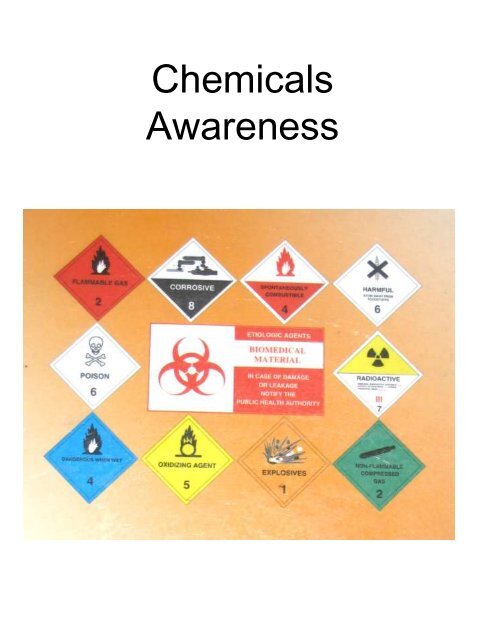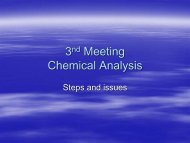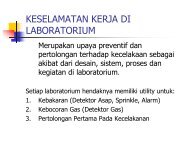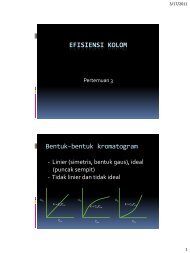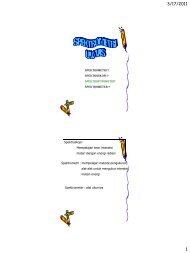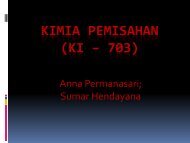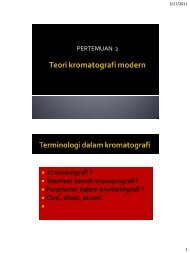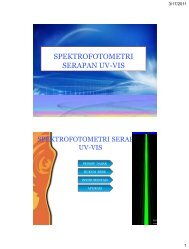Handling chemicals
Handling chemicals
Handling chemicals
Create successful ePaper yourself
Turn your PDF publications into a flip-book with our unique Google optimized e-Paper software.
Chemicals<br />
Awareness
The World of<br />
Chemicals<br />
• Universe of Chemicals ><br />
5 Million<br />
• Industrial Inventories ~<br />
55,000<br />
• Regulated<br />
Occupationally ~ 600<br />
2
Toxicology<br />
Poisons - the adverse effects (efek merugikan) of<br />
substances on living systems.<br />
“All substances are poisons; There is none<br />
which is not a poison. The right dose<br />
differentiates a poison from a remedy…”<br />
– Paracelsus (1493-1541)<br />
Chemical Toxicology – The potential adverse effects and<br />
control of <strong>chemicals</strong> in the workplace.<br />
3
Toxicants<br />
Toxins<br />
Poisons<br />
• Substances that produce adverse<br />
biological effects of any nature<br />
• May be chemical or physical in nature<br />
• Effects may be of various types (acute,<br />
chronic, etc.)<br />
• Specific proteins produced by living<br />
organisms<br />
(Mushroom toxin or tetanus toxin)<br />
• Most exhibit immediate effects<br />
Toxicants that cause immediate<br />
death or illness when experienced in<br />
very small amounts<br />
4
Basic Concepts<br />
• Toxicity – capacity to cause injury<br />
• Hazard – potential harm associated<br />
with a specific substance under<br />
potential exposure conditions<br />
• Risk – the likelihood or chance that<br />
harm will occur under actual<br />
conditions<br />
(Toxicity) X (Exposure) = Risk<br />
5
Basic Concepts<br />
• All <strong>chemicals</strong> have the capacity to<br />
be toxic<br />
• All <strong>chemicals</strong> act in the body<br />
according to the principles of<br />
chemistry, physics and biology<br />
• Natural <strong>chemicals</strong> are not inherently<br />
harmless<br />
• Synthetic <strong>chemicals</strong> are not<br />
inherently hazardous<br />
• The dose make the poison<br />
6
The Dose Makes the Poison<br />
Chemical Beneficial Dose Toxic Dose<br />
Aspirin 300-1000 mg 1000-30,000mg<br />
Vitamin A 500 units/d 50,000 units/d<br />
Oxygen 20% in air 50-100% in air<br />
7
Lethal Dose<br />
Agent LD 50 (mg/kg)<br />
Ethyl Alcohol 7060<br />
Sodium Chloride 3000<br />
Naphthalene 1760<br />
Ferrous Sulfate 1500<br />
Aspirin 1000<br />
Formaldehyde 800<br />
Ammonia 350<br />
Dextromethorphan Hydrobromide 350<br />
Caffeine 192<br />
Phenobarbital 150<br />
Chlorpheniramine Maleate 118<br />
DDT 100<br />
Strychnine Sulfate 2<br />
Nicotine 1<br />
Dioxin 0.0001<br />
Botulinus Toxin 0.00001<br />
8
There are no harmless<br />
substances.<br />
Only harmless ways of<br />
using substances.<br />
9
Routes of Chemicals<br />
Inhalation*<br />
Absorption<br />
Ingestion<br />
Injection<br />
*Most important<br />
route of entry<br />
Exposure<br />
Breathing Zone<br />
10<br />
Eyes
• How can you know that a<br />
chemical is toxic or hazardous?<br />
• How can you handle<br />
<strong>chemicals</strong>?<br />
• Is a chemical harmful?<br />
• How can we identify <strong>chemicals</strong>?<br />
MSDS<br />
HARM SYMBOOLS
Sumber : MSDS, Soemanto, Puslitbang LIPI (2000)
NO<br />
RANKING DAN SIMBOL BAHAYA BAHAN KIMIA<br />
MENURUT NEPA-USA<br />
BAHAYA KESEHATAN<br />
(HEALTH)<br />
4 Penyebab kematian,<br />
cedera fatal, meskipun<br />
ada pertolongan<br />
3 Berakibat serius pada<br />
keterpaan singkat,<br />
meskipun ada<br />
pertolongan<br />
2 Keterpaan intensif dan<br />
terus menerus berakibat<br />
serius, kecuali ada<br />
pertolongan<br />
1 Penyebab iritasi atau<br />
cedera ringan<br />
0 Tidak berbahaya<br />
terhadap kesehatan<br />
meskipun kena panas<br />
(api)<br />
Simbol<br />
bahaya<br />
Natrium<br />
BAHAYA<br />
KEBAKARAN (FIRE)<br />
Segera menguap dalam<br />
keadaan normal dan<br />
dapat terbakar secara<br />
cepat<br />
Cair atau padat, dapat<br />
dinyalakan pada suhu<br />
biasa<br />
Perlu sedikit pemanasan<br />
sebelum bahan dapat<br />
terbakar<br />
Dapat dibakar, tetapi<br />
memerlukan pemanasan<br />
lebih dulu<br />
Bahan tidak dapat<br />
dibakar sama sekali<br />
3<br />
1<br />
W<br />
2<br />
BAHAYA<br />
REAKTIVITAS<br />
(REACTIVITY)<br />
Mudah meledak atau<br />
diledakkan, sensitif<br />
terhadap panas dan<br />
mekanik<br />
Mudah meledak tetapi<br />
memerlukan penyebab<br />
panas dan tumbukan<br />
kuat<br />
Tidak stabil, bereaksi<br />
hebat, tapi tidak<br />
meledak<br />
Stabil pada suhu<br />
normal. Tetapi tidak<br />
stabil pada suhu tinggi<br />
Stabil, tidak reaktif<br />
meskipun kena panas<br />
atau suhu tinggi<br />
W<br />
Jangan<br />
disiram<br />
dengan air
Sumber : MSDS, Soemanto, Puslitbang LIPI (2000)
Sumber : MSDS, Soemanto, Puslitbang LIPI (2000)
Sumber : MSDS, Soemanto, Puslitbang LIPI (2000)
Sumber : MSDS, Soemanto, Puslitbang LIPI (2000)
Sumber : MSDS, Soemanto, Puslitbang LIPI (2000)
Sumber : MSDS, Soemanto, Puslitbang LIPI (2000)
Sumber : MSDS, Soemanto, Puslitbang LIPI (2000)
Sumber : MSDS, Soemanto, Puslitbang LIPI (2000)
Sumber : MSDS, Soemanto, Puslitbang LIPI (2000)
Sumber : MSDS, Soemanto, Puslitbang LIPI (2000)
Sumber : MSDS, Soemanto, Puslitbang LIPI (2000)
Sumber : MSDS, Soemanto, Puslitbang LIPI (2000)
Sumber : MSDS, Soemanto, Puslitbang LIPI (2000)
Sumber : MSDS, Soemanto, Puslitbang LIPI (2000)
Sumber : MSDS, Soemanto, Puslitbang LIPI (2000)
Sumber : MSDS, Soemanto, Puslitbang LIPI (2000)
Sumber : MSDS, Soemanto, Puslitbang LIPI (2000)
Sumber : MSDS, Soemanto, Puslitbang LIPI (2000)
Chemicals awareness<br />
1. Solid<br />
Chemicals<br />
Solid Liquids Gas<br />
a. Unhygroscopic solid, and can not<br />
menyublim, example : amylum, sodium<br />
carbonate<br />
b. Hygroscopic solid, exp: NaOH, KSCN<br />
c. Vapourable solid<br />
exp: Iodium, Ammonium carbonate,<br />
Kamper (naftalen)
d. Light sensitive solid: exp: AgNO 3, KMnO 4<br />
e. Water sensitive solid, exp: Na, K.<br />
f. Oxygen/air sensitive solid,Exp: phosphorous<br />
2. LIQUID<br />
a. Liquid/Normal, exp: aquadest,<br />
b. Vapourable liquid, exp: ammonia, ether, HCl,<br />
acetone, chloroform<br />
c. Liquid that easy to bind water vapour,<br />
Exp: Sulphuric acid<br />
a. Flamable liquid, exp: ether, methanol,<br />
aceton, gasoline, kerosine
Hygroscopic solid: placed<br />
into covered bottled, wrapt with<br />
plastic<br />
vapourable solid: place into glass<br />
bottle or plastic, rest a ¼ of space<br />
for air.
light sensitive solid: placed into dark<br />
bottle or tak tembus cahaya,cover it<br />
tightly<br />
water sensitive solid:<br />
immersed into kerosine<br />
oxygen/air sensitive solid: place and<br />
immesed in water<br />
do not place a solid mixtures as<br />
oxidators, catalist and substance that<br />
easy to burn<br />
exp: KClO 3, MnO 2, sucrose
. Liquid<br />
placed in closely pack bottle<br />
spare the space a ¼ part of the bottle for liquid<br />
vapour<br />
the flamable liquid have to keep away from fire<br />
for oxidator liquids, place into fumehood<br />
Use the suitable SPA if you want to take<br />
harmful liquids<br />
• Do not put the harmful liquids in the up side of<br />
rack
Handle <strong>chemicals</strong><br />
Toxic vapourable<br />
<strong>chemicals</strong> should<br />
be placed in<br />
fumehood<br />
Use fumehood if<br />
you work with<br />
hazardous<br />
<strong>chemicals</strong>
c. Gas<br />
Place the gas vessel safely<br />
use kran with spuyer that have to<br />
maintain periodically<br />
place in cold room (if it is possible)<br />
keep away from heat<br />
or fire<br />
keep the vessel safe<br />
(make not easy to fall)<br />
He
Work Laboratory Instruction<br />
1. Identify 5 <strong>chemicals</strong> in the front desk.<br />
2. Find the MSDS of its in MSDS Book.<br />
3. Report your work into journal<br />
Chemicals Formula Structure Harm<br />
symbols<br />
<strong>Handling</strong>


